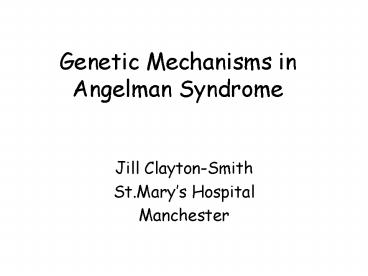Genetic Mechanisms in Angelman Syndrome - PowerPoint PPT Presentation
1 / 30
Title:
Genetic Mechanisms in Angelman Syndrome
Description:
1. Angelman Syndrome is due to a deletion of 15q11-13 in 65% of cases ... may arise due to failure to reset the parental imprint during gametogenesis ... – PowerPoint PPT presentation
Number of Views:1347
Avg rating:3.0/5.0
Title: Genetic Mechanisms in Angelman Syndrome
1
Genetic Mechanisms in Angelman Syndrome
- Jill Clayton-Smith
- St.Marys Hospital
- Manchester
2
Angelman Syndrome
- Severe learning disability
- Ataxic, jerky movements
- Seizure disorder
- Absent speech
- Characteristic facial features
- Happy, sociable affect
Harry Angelman 1965
3
1. Angelman Syndrome is due to a deletion of
15q11-13 in 65 of cases
Kaplan et al., Magenis et al., 1987
4
Deletions are detected more easily by FISH
analysis
5
Principle of FISH
A T C etc
DNA sequence of 15q11-13
q11-13
15
T A G
T A G
Gene probe, a piece od DNA which matches The
sequence in 15q11-13 and will stick to it Probe
is made to fluoresce
6
Principle of FISH
Normal 15. Probe sticks to 15q11-13
and shines
Deleted 15. Probe doesnt stick No
signal
7
15q11-13 deletions tend to be of a similar size
4 Mb
bp bp bp
duplicon repeat sequences of DNA
bp common breakpoints
8
Chromosome 15q11-13 is an imprinted region
Genetic information from the maternal and
paternal chromosome 15q11-13 regions is expressed
differently
The parental imprint is set during formation
of the egg and the sperm
mat pat
An intact maternal and paternal chromosome
15q11-13 are needed for normal development
9
In Angelman syndrome the deletion arises on the
maternally inherited chromosome
m p
A deletion arising on the paternal chromosome
gives rise to the Prader-Willi syndrome
m p
Almost all deletions arise de novo
10
Maternal and Paternal 15q11-13show Differential
Methylation
methylation analysis
N AS PWS
CH3
m p
M P
11
Some deletions arise due to a parental
chromosome rearrangement
AS
PWS
12
Parental chromosome rearrangement
inv(15)
inv(15) inv(15)
AS del 15q11-13
PWS
del 15q11-13
13
2. Angelman Syndrome May Arise as a Result of
Paternal Uniparental Disomy
Two paternal chromosome 15s No maternal 15.
Accounts for 3 AS
p p
trisomy rescue
mitotic error
meiotic error
14
3. Angelman Syndrome may arise due to failure to
reset the parental imprint during gametogenesis
Imprinting defect
m p
Intact chromosomes are inherited from both
parents but the maternal chromosome has a
paternal imprint
15
The Imprinting Centre Controls Setting of the
Parental Imprint
4kb
IC
bp bp bp
duplicon repeat sequences of DNA
bp common breakpoints
imprinting centre (IC)
16
Imprinting Defects
- Mutation within the imprinting centre
- No mutation identified. Failure of imprint to be
reset is a chance (stochastic) event - Mosaic imprinting defect
17
4. Angelman Syndrome may arise due to a mutation
within the UBE3A gene
4kb
IC UBE3A
bp bp bp
UBE3A gene
duplicon repeat sequences of DNA
bp common breakpoints
imprinting centre (IC)
18
UBE3A mutation
Point mutation within the UBE3A gene leads to
lack of normal expression of gene
m p
19
UBE3A gene
- Responsible for producing a protein called a
ubiquitin protein ligase which is involved in
protein degradation within the brain - Only the maternal copy is active in brain
- The gene works in specific regions of the brain
involved in learning, memory and movement
20
Angelman Syndrome Mouse Model-Impaired
contextual learning and memory
21
UBE3A gene
1 2 3 4 5 6 7 8 9
10 11 13 14 15 16
truncating
missense
HECT domain
splice site
polymorphism
22
UBE3A mutation may be familial
AS
23
UBE3A mutations may be familial due to the mother
carrying the fault in her ovaries, but not blood
AS AS
This is called GONADAL MOSAICISM
24
UBE3A mutations
- Found in 80 familial AS and 20 sporadic AS
- Not present in mother in 75 sporadic cases
- Mother carries mutation in 20 cases
- Significant number of mothers are gonadal mosaics
so pre-natal diagnosis recommended
25
5. Clinical features of AS with no genetic
abnormality
- Not AS. Consider other diagnoses.
- Mutations not detectable by current techniques
- Another genetic mechanism
- Another transcript of UBE3A
- Another gene
- Mosaicism
26
Summary
recurrence risk
I De novo deletion 75 low
Familial rearrangment 1 can be
high II Uniparental disomy 3
low III Imprinting defect 2 low
(no IC mut/de novo)
50(parental mut) IV
UBE3A mutation 5-10 low (de novo)
high(familial/gon.mosaic) V Clinical
diagnosis alone 10-12 12
27
deletion of maternally inherited 15
paternal uniparental disomy
imprinting defect UBE3A mutation on
maternal 15 no detectable abnormality
methylation test
ve
P M
ve
P P
ve
P M
-ve
P M
-ve
P M
28
Algorithm for Genetic Testing
Clinical suspicion of AS
methylation analysis
ve
-ve
FISH
typical AS
clinical review
no del
screen UBE3A
del15q
not AS
RFLP analysis
no mut.
UBE3A mutation
no UPD
UPD
keep on review
Imprinting defect
Screen for IC mutation
29
Lessons We Have Learned
- Not everyone with AS has the typical features
- The behaviour is the most consistent feature. If
its typical, keep looking at the AS gene/region - There is a lot of overlap in ability between
del/UPD/UBE3A/Imprintor - Mosaics are likely to be more difficult to pick
up - UBE3A mutations are not that uncommon gt50
detected in our lab so far
30
Questions?































